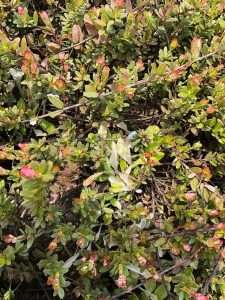Weed Management Research Update

While cranberry growers have a decently sized herbicide toolbox, the spectrum of weed species is very broad and includes many perennials not found in other cropping systems. These unique species, as well as those that escape current control options (such as Northern St. Johnswort), justify the need for additional tools. Our current work is focused on identifying new herbicides to control troublesome weeds without injuring cranberries, shepherding those tools through the registration process, and supporting growers with practical and affordable use patterns.
In 2023 we have several studies at various application timings to explore more holistic, season-long weed management options:
- New plantings. In previous work we’ve found that there’s a difference in cranberry herbicide tolerance and the weed species spectrum in new plantings compared to established, bearing beds. Oftentimes, new plantings are plagued by annual weeds until the vines establish a competitive ground cover. In this study, we’re investigating four herbicides, three of which are registration-ready, at several potential use rates in a bed planted this June.
- Dormant herbicide applications in established bearing beds. Casoron continues to be a valuable tool for early-season control, but a broader suite of herbicides would allow growers to control more diverse weed species and reduce the risk for resistant weed selection. In this study we have three herbicides that are registration ready at various potential use rates. One herbicide in particular is looking quite promising, controlling a broad spectrum of weeds ranging from sheep sorrel to perennial grasses (see photo). We’ll take this study to yield to determine any impacts on berry production and quality.
- Post-bloom late season weed control study. In this work we’re looking at an herbicide that would be exempt from the residue establishment process, which would save years of lab studies before registration. Our focus is on late-season weeds that escape current tools, such as dewberry.
- Wiper studies. When all else fails, we need more options to control the really troublesome escapes that grow above the canopy and are difficult to remove by hand, such as maples. This research project includes four potential herbicides that could be used alone or in combination in a wiper treatment.
- “Weed zoo”. While it’s obviously critical to find new herbicides that don’t injure cranberries or impact berry yield and quality, we also need to have a good idea of what these options offer for weed control compared to existing tools. With that in mind, we conduct a “weed zoo” study each year in an abandoned, weedy cranberry bed to get an idea of the control spectrum for each of the active ingredients described above.
We look forward to sharing some of this work with the cranberry community at the summer field day!
This article was posted in Cranberry, Other News and Resources and tagged Cranberries, Herbicides, Jed Colquhoun, Weed Management, Weeds.
